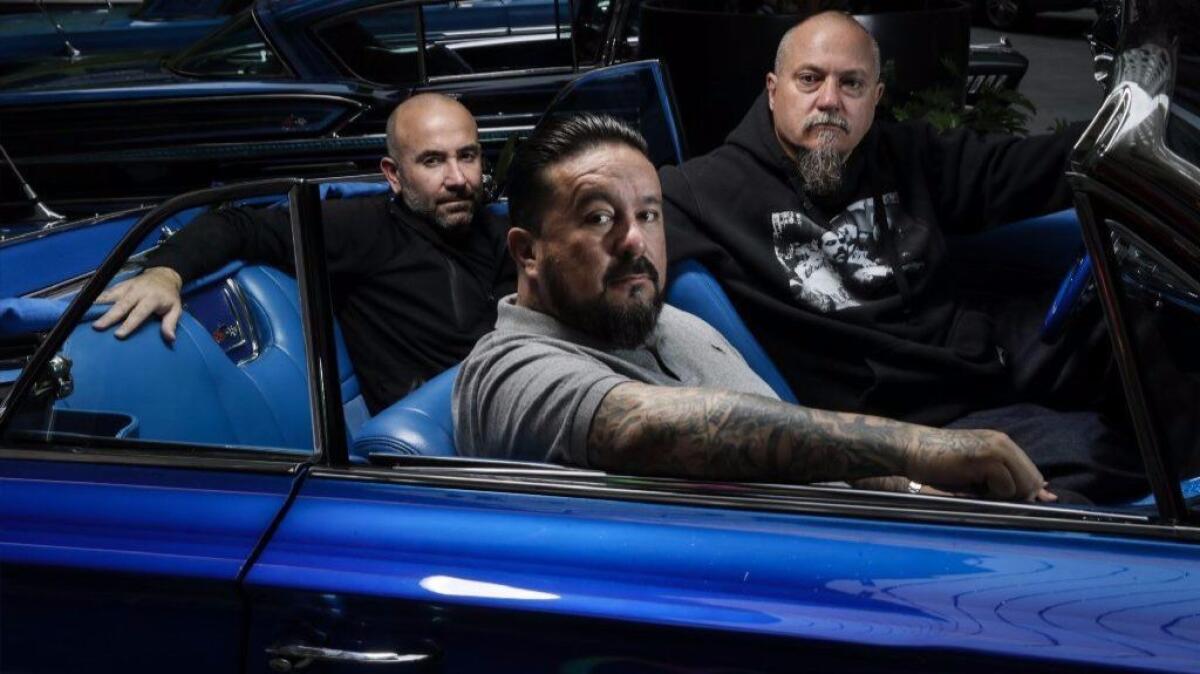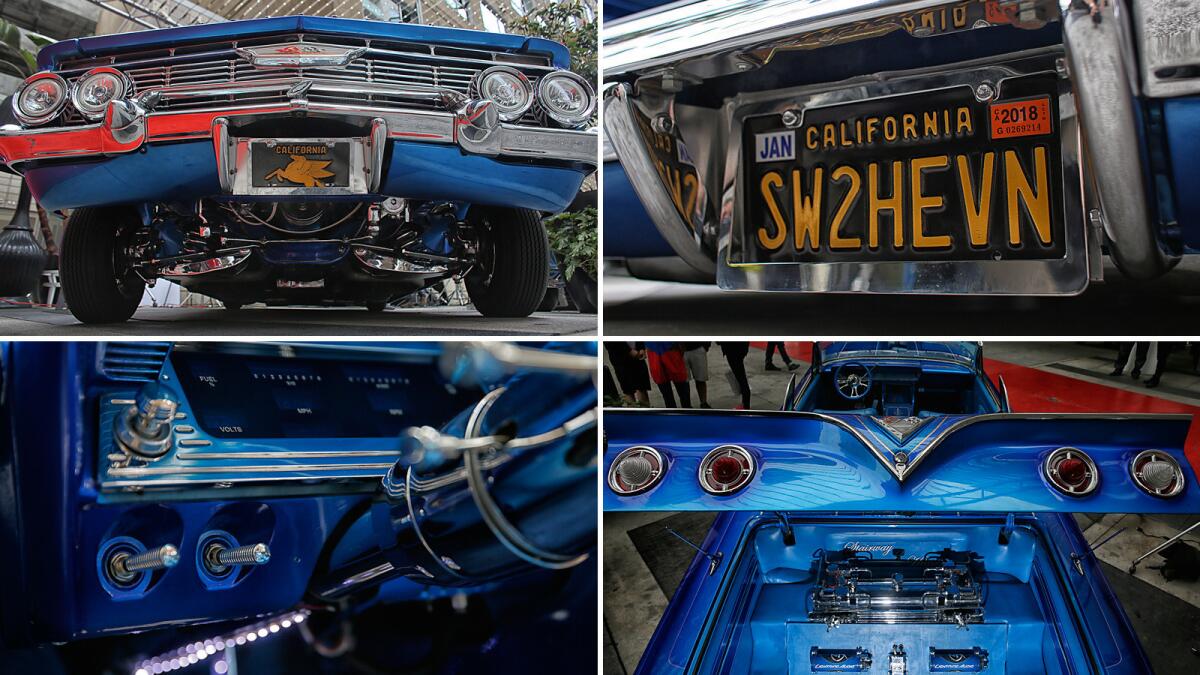With ‘Lowriders,’ peek into East L.A.’s custom-car culture
On any given day, Angelenos can be treated to traveling art galleries rich with uniquely American culture and California-grown talent — if only they viewed lowriders, the custom old-school cars tricked out with candy-colored paint, the shiniest chrome and hydraulics, as the artistry in motion they are. That’s all that Estevan Oriol and Mister Cartoon really want.
“I want people to realize that these cars are a work of art and our expression,” says Cartoon, a.k.a. Mark Machado.
“To us,” Oriol adds, “it's an art piece with an engine and wheels.”
But when many people see lowriders cruising through the city, thoughts of gangs, drugs and violence come to mind. Such expectations, often rooted in stereotypes about the men and women found in the driver’s and passenger seats, rob the long-standing tradition from the familial roots at its core. There truly is more to lowriding than meets the eye.
For these reasons, the two heavyweights in East L.A.’s lowriding scene lent their expertise and names, as executive producers, to “Lowriders,” opening in theaters Friday. The film is being heralded as the first major feature inspired by the people and traditions of the lowrider culture.

“I think this movie will relax a lot of people,” Cartoon says. “They associate our cars with bank robberies and all this stuff [they’ve seen in other movies], so they get scared when they see them. But now I think things are changing, where people get happy to see a bouncing car.”
“Lowriders,” is a coming-of-age tale about a young street artist, played by Gabriel Chavarria (“East Los High”), straddling life between his father (a convincing
Oriol, a bouncer turned hip-hop act manager, photographer and music video director for the likes of Eminem, Travis Barker and Cypress Hill, has been documenting the car-building he and Cartoon have done for 25 years. The idea for the film, more than 10 years in the making, came out of those images. After staging an event for Nike at which they met Brian Grazer, the duo presented doc footage to the Oscar-winning producer known for “A Beautiful Mind,” “American Gangster” and “8 Mile.” Inspired to create a feature, Jason Blum joined the project, which was initially set to be based on the duo’s lives.
Oriol and Cartoon spent more than eight years looking at different scripts. A few years ago, the film’s current approach was selected. “Luke Cage’s” Cheo Hodari Coker and “Little Bird’s” Elgin James were brought on as writers, though “Kicks’” Justin Tipping and Joshua Beirne-Golden, both listed as co-producers on the film, also had some involvement.
The picture was directed by the Peru-born Ricardo de Montreuil, known for the Spanish-language films “La mujer de mi hermano” and “Máncora.” He says he was attracted to the story because of the “amazing” lowrider subculture, which he experienced after moving to L.A. from Miami 12 years ago — a culture uniquely Mexican American.
The art of lowriding, born on L.A.'s Eastside, gets supercharged »
“Why is Hollywood not telling stories from this community?,” he remembers thinking. “I found it more interesting and diverse and vibrant than the typical Beverly Hills movie or Venice movie. Why not tell stories from this more relatable side of town?”
De Montreuil believes the coming-of-age vantage from which the film is told is the perfect way in for those not familiar with lowrider culture — because at the core of the story is a universal theme of self-discovery.
“When you’re young, many people tend to try to fit in to be cool,” he says, “and a lot of times you run from your background because you don’t want to be associated with it. The beautiful irony of it is that when you grow older, you realize that the most valuable thing you own is who you are and where you come from.”
And in the case of “Lowriders,” the film and the culture, one realizes that this world created in Southern California by Latinos is “part of the American cultural fabric,” De Montreuil says, and influences the world.
Lowriders have taken Cartoon and Oriol to Amsterdam, Thailand and Tokyo, among other places. (There is even a vibrant scene in Brazil.) But neither of them thought the breadth of their reach was possible. They just wanted to be the best on the boulevard.
Everyone takes their car to the boulevard to compete. You battle with your paint jobs, your hydraulics.
— Mister Cartoon
“The boulevard is our Studio 54, our nightclub,” Cartoon says. “Everyone takes their car to the boulevard to compete. Most of it’s friendly; you battle with your paint jobs, your hydraulics. It’s about showing off your car’s paint job and your style, because that personality is reflected on that car. And you either have taste or your don’t — or you have too much taste.
“The foam on the latte are the people who have taste.”
Being the best, however, gives rise to competition, friendly and otherwise. But all associations of gang violence are actually “on the outside of it,” Cartoon says, especially considering the history of the culture where, “in the ’70s, lowriders were looked at as pretty boys.” While the lowriding community did have clashes with the LAPD, prompting a crackdown in the 1990s, a new generation of “hip-hop cops who knew lowriders aren’t that bad,” Cartoon says, helped usher in the culture’s legal resurgence in the early 2000s.
In an effort to continue a sort of re-education of perceptions about the community, Cartoon and Oriol were responsible for all of the imaging in “Lowriders,” including the tattoos on actors’ arms, the prominently displayed graffiti and the car designs and murals. They even hand-picked cars to fit a particular color palette for the film, to help “let people know why we’re attracted to it, the beauty of it,” Cartoon says.

Their participation gives the movie a palpable authenticity, especially necessary considering the controversy it caused when filming took place in El Sereno two years ago.
Eastside Cafe, a cultural and educational space next door to 3 C's Car Automotive, where a number of the movie’s scenes were shot, blasted the picture for perpetuating stereotypes and exploiting the mostly Latino community.
"Eastside Cafe does not support Low Rider exploitation film," said a sign posted at the establishment when the shooting was taking place.
On Facebook, the cafe criticized the film production for taking up parking spaces and blocking traffic and for painting "over a memorial mural that mourned the death of a young boy of our community."
"We're fighting on high moral ground for respect for the community," Roberto Flores, a coordinator with Eastside Cafe said to a Times reporter in 2015. "They're selling our culture and they never give anything back."
Cartoon, however, ensures that is not the case.
“It’s our work of art driving down Sunset or Crenshaw or Whittier Boulevard,” he says. “We’re not trying to sell it. We just want people to peek in for a little bit.”
Time staff writer Brittny Mejia contributed to this article.
Only good movies
Get the Indie Focus newsletter, Mark Olsen's weekly guide to the world of cinema.
You may occasionally receive promotional content from the Los Angeles Times.








